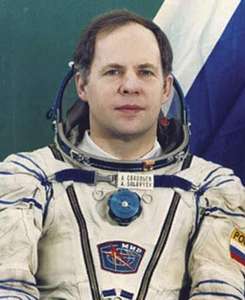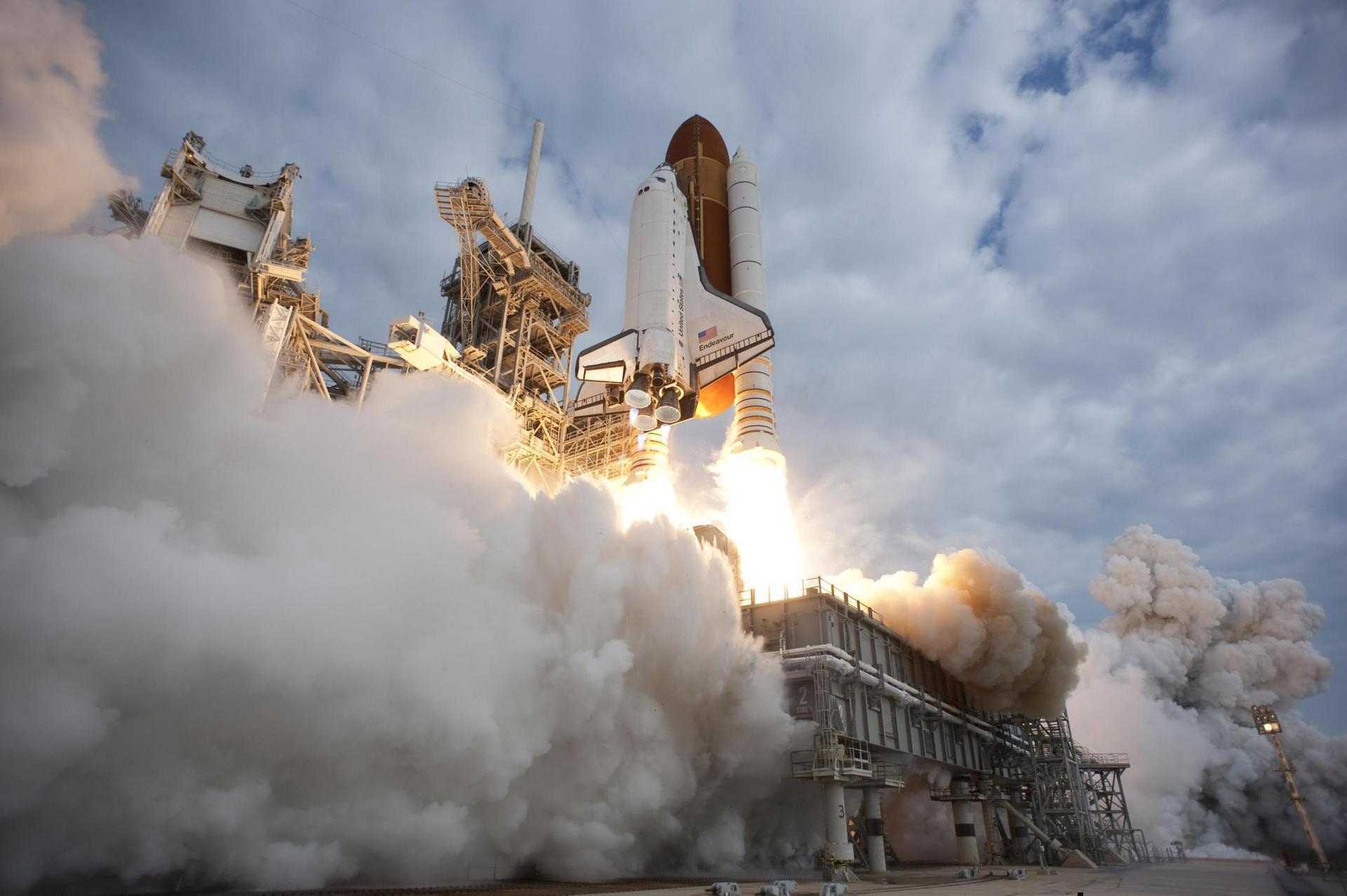Anatoly Solovyev
Russian - (RFSA)
Retired
Date of Birth: Jan. 16, 1948
Age: 77
Anatoly Yakovlevich Solovyev (Russian: Анатолий Яковлевич Соловьёв; born January 16, 1948 – alternate spelling "Solovyov") is a retired Russian and Soviet cosmonaut and pilot. Solovyev holds the world record on the number of spacewalks performed (16), and accumulated time spent spacewalking (over 82 hours).
Soyuz-U2 | Soyuz TM-4
Soviet Space Program | RussiaBaikonur Cosmodrome, Republic of Kazakhstan
Dec. 21, 1987, 11:18 a.m.
Status: Success
Mission:
Soyuz TM-4 was the fourth mission to Mir space station. The mission began on December 21, 1987, 11:18:03 UTC, launching Commander Vladimir Titov, Flight Engineer Musa Manarov and Research Cosmonaut Anatoli Levchenko into orbit. They docked with Mir two days later. During their stay there, crew carried out over 2000 various experiments, performed two EVAs. They were visited by Soyuz TM-5 and Soyuz TM-6 crews. Vladimir Levchenko spent only a week on the station, while other two members of the crew stayed for a long duration mission. They returned on a Soyuz TM-6 spacecraft, landing safely back on Earth on December 21, 1988, 09:57:00 UTC.
Low Earth OrbitSoyuz-U2 | Soyuz TM-5
Soviet Space Program | RussiaBaikonur Cosmodrome, Republic of Kazakhstan
June 7, 1988, 2:03 p.m.
Status: Success
Mission:
Soyuz TM-5 was the fifth mission to Mir space station. The mission began on June 7, 1988, 14:03:13 UTC, launching Commander Anatoly Solovyev, Flight Engineer Viktor Savinykh and Research Cosmonaut Aleksandr Aleksandrov into orbit. They docked with Mir two days later, meeting with the long-duration resident crew. During their 7-day stay there, cosmonauts carried out scientific experiments. They returned on a Soyuz TM-4 spacecraft, landing safely back on Earth on June 17, 1988, 10:12:32 UTC.
Low Earth OrbitSoyuz-U2 | Soyuz TM-9
Soviet Space Program | RussiaBaikonur Cosmodrome, Republic of Kazakhstan
Feb. 11, 1990, 6:16 a.m.
Status: Success
Mission:
Soyuz TM-9 was the ninth mission and the sixth long-duration expedition to Mir space station. The mission began on February 11, 1990, 06:16:00 UTC, launching Commander Anatoly Solovyev and Flight Engineer Aleksandr Balandin into orbit. They docked with Mir two days later. During their stay there, cosmonauts performed two EVAs, various station maintenance tasks, and carried out scientific experiments in biology, geophysics, space technology, astronomy etc. The mission concluded with a safe landing back on Earth on August 9, 1990, 07:33:57 UTC.
Low Earth OrbitSoyuz-U2 | Soyuz TM-15
Soviet Space Program | RussiaBaikonur Cosmodrome, Republic of Kazakhstan
July 27, 1992, 6:08 a.m.
Status: Success
Mission:
Soyuz TM-15 was the 15th mission and the 12th long-duration expedition to Mir space station. The mission began on July 27, 1992, 06:08:42 UTC, launching Commander Anatoly Solovyev, Flight Engineer Sergei Avdeyev and Research Cosmonaut Michel Tognini into orbit. They docked with Mir two days later. During their stay there, cosmonauts performed EVAs, various station repair and maintenance tasks, and carried out scientific experiments in materials research, space technology, astrophysics and earth observation. They were visited by several Progress resupply spacecrafts, and welcomed aboard the Soyuz TM-16 crew. The mission concluded with a safe landing back on Earth on February 1, 1993, 03:49:57 UTC.
Low Earth OrbitSoyuz-U2 | Soyuz TM-21
Soviet Space Program | RussiaBaikonur Cosmodrome, Republic of Kazakhstan
March 14, 1995, 6:11 a.m.
Status: Success
Mission:
Soyuz TM-21 was the 21st mission and the 18th long-duration expedition to Mir space station. It was also a part of the US/Russian Shuttle-Mir Program. The mission began on March 14, 1995, 06:11:34 UTC, launching Commander Vladimir Dezhurov, Flight Engineer Gennady Strekalov and Research Cosmonaut Norman Thagard (who became the first American to ride the Soyuz) into orbit. They docked with Mir two days later. During their stay there, cosmonauts performed several EVAs to prepare for the docking of the new Spektr module. Station crew was visited by several Progress resupply spacecrafts, and welcomed aboard the STS-71 with the 19th expedition crew. Crews exchanged vehicles, and members of the 18th expedition returned aboard STS-71, landing safely back on Earth on 7 July 1995, 14:55:28 UTC. Soyuz TM-21 brought back the 19th expedition later on September 11, 1995, 06:52:40 UTC.
Low Earth OrbitSpace Shuttle Atlantis / OV-104 | STS-71
National Aeronautics and Space Administration | United States of AmericaKennedy Space Center, FL, USA
June 27, 1995, 7:32 p.m.
Status: Success
Mission:
STS-71 was the third mission of the US/Russian Shuttle-Mir Program and the first Space Shuttle docking to Russian space station Mir. It started on 27 June 1995 with the launch of Space Shuttle Atlantis from launch pad 39A at the Kennedy Space Center in Florida. The shuttle delivered a relief crew of two cosmonauts Anatoly Solovyev and Nikolai Budarin to the station and recovered Increment astronaut Norman Thagard. Atlantis returned to Earth on 7 July with a crew of eight. It was the first of seven straight missions to Mir flown by Atlantis.
Low Earth OrbitSoyuz-U | Soyuz TM-26
Russian Federal Space Agency (ROSCOSMOS) | RussiaBaikonur Cosmodrome, Republic of Kazakhstan
Aug. 5, 1997, 3:35 p.m.
Status: Success
Mission:
Soyuz TM-26 was the 32nd mission and the 24rd long-duration expedition to Mir space station. It was also a part of the US/Russian Shuttle-Mir Program. The mission began on August 5, 1997, 15:35:54 UTC, launching Commander Anatoly Solovyev and Flight Engineer Pavel Vinogradov into orbit. They docked with Mir two days later. During their stay there, cosmonauts performed several EVAs and various scientific experiments in medicine, biotechnology, Earth sciences etc. Station crew was visited by several Progress resupply spacecrafts, STS-86 and STS-89, and welcomed aboard Soyuz TM-27 with the next expedition crew. The mission concluded with a safe landing back on Earth on February 19, 1998, 09:10:30 UTC.
Low Earth OrbitThe Roscosmos State Corporation for Space Activities, commonly known as Roscosmos, is the governmental body responsible for the space science program of the Russian Federation and general aerospace research. Soyuz has many launch locations the Russian sites are Baikonur, Plesetsk and Vostochny however Ariane also purchases the vehicle and launches it from French Guiana.
Electron
Symphony In The Stars
Rocket Lab Launch Complex 1B - Rocket Lab Launch Complex 1, Mahia Peninsula, New Zealand'Symphony In The Stars' is the first of two dedicated missions on Electron to deploy a single spacecraft to a 650km circular Earth orbit for a confid…
Falcon 9
Starlink Group 10-34
Space Launch Complex 40 - Cape Canaveral SFS, FL, USAA batch of 27 satellites for the Starlink mega-constellation - SpaceX's project for space-based Internet communication system.
Electron
Get The Hawk Outta Here (4x HawkEye 360)
Rocket Lab Launch Complex 1A - Rocket Lab Launch Complex 1, Mahia Peninsula, New ZealandHawkEye 360 is a a space-based civil global intelligence satellite network using radio frequency (RF) technology to help monitor transportation acros…
Falcon 9
Starlink Group 10-16
Space Launch Complex 40 - Cape Canaveral SFS, FL, USAA batch of 27 satellites for the Starlink mega-constellation - SpaceX's project for space-based Internet communication system.
Falcon 9
Axiom Space Mission 4
Launch Complex 39A - Kennedy Space Center, FL, USAThis is a Crew Dragon flight for a private company Axiom Space. The mission will carry a professionally trained commander alongside three private ast…





